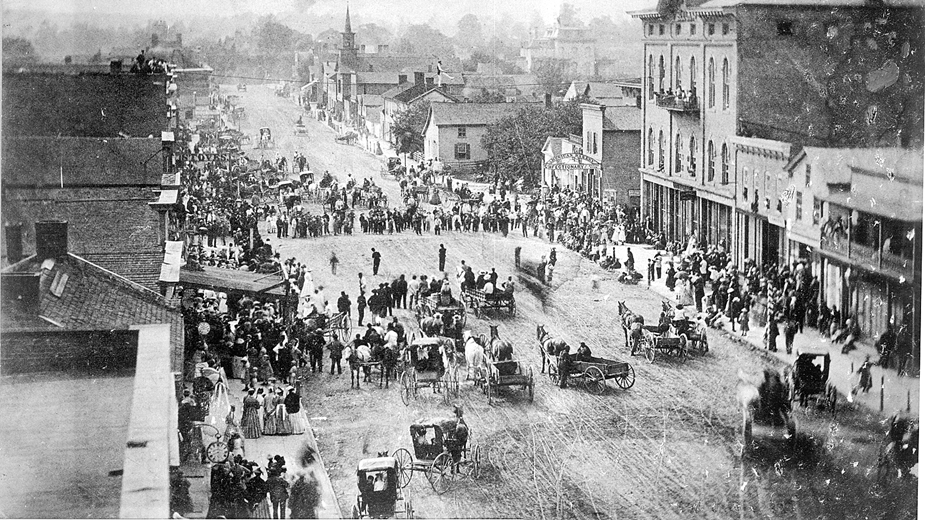The Stories Behind Old Snapshots of Youngstown
YOUNGSTOWN, Ohio – Ansel Adams, famous for his spectacular images of the West, observed, “A photograph is usually looked at – seldom looked into.”
These four photos at the Mahoning Valley Historical Society are all well worth looking into. All were featured in “Pictures Worth a Thousand Words,” a lecture Mahoning Valley Historical Society Executive Director Bill Lawson gave recently as part of the “Bites and Bits of History” lunch program.
They provide a glimpse into three eras, showing anew pages of Youngstown history.
‘The Great’ Blondin Crosses Federal Street On a Tightrope
It’s 1869. Horses and buggies are parked in the middle of downtown. The pedestrians have stopped to look skyward. Above them, perched seemingly precariously on a tightrope, is Charles “The Great” Blondin.
In the photo at top, Blondin is midway from the top of Excelsior Hall, the first theater in Youngstown and the future site of the Paramount/Liberty Theater, and the Gerstle building.
Blondin achieved worldwide fame after walking above Niagara Falls in 1859.
“He hit the road after that, using his fame, and would go to towns all over the place – including Youngstown in the summer of 1869 – putting on a tightrope walking show,” Lawson says.
Central Square Icons
The Stambaugh Building is being transformed into a Hilton DoubleTree hotel, but the other two buildings pictured here, once well-known landmarks, are long gone.

This 1942 photograph shows the edge of the Central Square branch of the public library, which stood from the early 1920s to the 1950s. In the background is the Palace Theater, a 2,300-seat venue that featured the best in vaudeville and movies.
During this time period, the Palace, which had a large stage, attracted the best big bands in the country, such as the Tommy Dorsey Band (featuring Frank Sinatra) and Glen Miller.
By 1942, vaudeville was dying, but signage that advertised this type of entertainment still decorated the roof of the theater.
The decline of the large movie houses downtown began during the early 1960s. The Palace closed in 1964 – the site is a parking lot today – 38 years after it opened. It fell to the wrecking ball in 1966. A proposal to build a mall with attached Cinerama Theater never got off the ground.
An Immigrant Family from East Federal Street
This family of Italian immigrants lived in a slum along East Federal Street, which stood about where the Youngstown post office sits today.

Disheveled and surrounded by ramshackle housing, they still seem to be genuinely happy to be posing for the camera, Lawson said at his lecture.
“They’re still smiling,” he says.
Families like this received help from the Christ Mission Settlement – now the Rescue Mission of Mahoning Valley – and support in assimilating into their adopted home.
The Christ Mission took this photo, possibly to document its work on the East End.
“Always in our history, there are people coming from elsewhere that end up in bad situations here in the United States,” Lawson says. “And there are always groups working to help improve their lives.”
A Sign of Language Diversity
Photographed outside the employment office of the Youngstown Sheet & Tube Co. during the early 20th century, this picture “speaks to the issue of diversity in the Mahoning Valley,” Lawson says.

The English text of a safety sign is translated into five languages: Hungarian, Romanian, German, Czech and Slovak.
The sign points to the mosaic of ethnicities that had developed in the Mahoning Valley. It also speaks to the language barriers recent immigrants faced, Lawson says.
The specific reason for focusing on these five languages is not known. “All of these languages were spoken in the Austro-Hungarian Empire,” Lawson says.
Lawson speculates that Sheet & Tube was actively recruiting employees from that area of Europe.
Copyright 2024 The Business Journal, Youngstown, Ohio.



